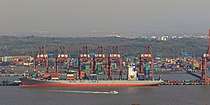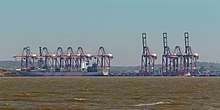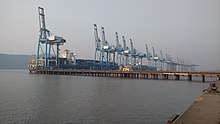Jawaharlal Nehru Port
Jawaharlal Nehru Port, abbreviated as JNPT, also known as Nhava Sheva, is the largest container port in India.[4][5] Located east of Mumbai (previously known as 'Bombay') in Navi Mumbai, Maharashtra, this port on the Arabian Sea is accessed via Thane Creek.[6] Its common name derives from the names of Nhava and Sheva villages that were situated here. This port is also the terminal of Western Dedicated Freight Corridor (in construction).
| Jawaharlal Nehru Port Trust | |
|---|---|
 A container ship at Nhava Sheva | |
| Location | |
| Country | India |
| Location | Navi Mumbai, Maharashtra |
| Coordinates | 18°57′N 72°57′E[1] |
| Details | |
| Operated by | Jawaharlal Nehru Port Trust |
| Owned by | Government of India |
| Statistics | |
| Annual cargo tonnage | Bulk: 7.88 million tons (2010-11)[2] Container: 56.43 million tons (2010-11) |
| Annual container volume | 5.05 million TEU (2018-19)[3] |
| Website jnport | |
History
The port was established on 26 May 1989.
JN Port is the biggest container handling port in India, handling around 55% of the country’s containerized cargo, crossing the historic landmark of 4 million TEUs (Twenty-foot equivalent units) in container throughput consecutively for the last five years. In its coveted role as the Hub Port on the West Coast of India, JNP is ranked 28th among the top 100 Container Ports in the world.
Having set for itself a long-term goal of achieving 10 million TEUs by the year 2020-21, through addition of two more Terminals, viz. the 330M Stand-alone Container Terminals (DP World) and the 4th Container Terminal (Port of Singapore Authority) and a Satellite Port at Vadhvan Point, JNP throws open an array of worthwhile opportunities for the maritime trade, including the shipping lines and shippers, to ferry their cargo to various sectors across the globe.
JNP consist of a full-fledged Custom House, 30 Container Freight Stations and connectivity to 52 Inland Container Depots across the country. The hinterland connectivity both by rail and road is being further strengthened by ongoing projects like the Dedicated Freight Corridor (DFC), which will increase the existing train capacity of 27 to 100 trains per day; Multi-Modal Logistics Park (MMLP) and widening of the Port road connectivity. Its proximity to the Cities of Mumbai, Navi Mumbai and Pune; airports; hotels, exhibition centres, etc. gives the Port an extra edge to address the shippers’ needs, efficiently and promptly.
Facilities
The JNP Trust (JNPT) Container Terminal is operated by JNPT. It has a quay length of 680 metres (2,230 ft) with 3 berths.[7]
The Nhava Sheva International Container Terminal (NSICT) is leased to a consortium led by P & O, now a part of DP World. Commissioned in July 2000, it has a 600 metres (2,000 ft) quay length with two berths. It can handle up to 62.15 million tons of cargo.[8] NSICT was India’s first privately managed container terminal. In the year 2006, GTI (Gateway Terminals India Pvt Ltd), a third container terminal operated by APM Terminals, with the capacity to handle 1.3 Million TEUs was commissioned. A new standalone container terminal by the name of NSIGT having a quay length of 330 m and a capacity of 12.5 Million Tonnes will be fully operational by July, 2016. Work has commenced for commissioning of fourth container terminal with a quay length of 2,000 m. This terminal will be operated by PSA and will have a capacity of 4.8 Million TEUs (60 MTPA). Phase-I of the project with a quay length of 1 km will be commissioned by Dec., 2017.
In 2006 the port implemented the logistics data tagging of containers.[9] JNPT houses India’s best logistics connectivity with facilitation from Container Freight Stations and Logistics parks owned by government as well as private players namely Maharashtra State Warehousing Corporation, DRT, Gateway District Park, Allcargo, Avashya, Continental Warehousing, Ameya Logistics, TransIndia and Contegrate Entrepot. JNPT authorities have been trying to implement direct port delivery model of the containers, a first of its kind model promoted under the ease of doing business in India.
Traffic

JNP accounts for more than half of total container volumes handled at India's 12 public ports and around 40 percent of the nation's overall containerized ocean trade.[5] Major exports from Jawaharlal Nehru Port are textiles, sporting goods, carpets, textile machinery, boneless meat, chemicals and pharmaceuticals. The main imports are chemicals, machinery, plastics, electrical machinery, vegetable oils and aluminium and other non-ferrous metals. The port handles cargo traffic mostly originating from or destined for Maharashtra, Madhya Pradesh, Gujarat, Karnataka, as well as most of North India.

See also
References
- "Geographic Location". Jawaharlal Nehru Port Trust. Archived from the original on 17 October 2011. Retrieved 23 September 2011.
- "Cumulative Traffic April 2010 to March 2011" (PDF). Jawaharlal Nehru Port Trust. Archived from the original (PDF) on 19 March 2012. Retrieved 23 September 2011.
- "JNPT crosses 5 mn TEUs of container handling in 2018". The Hindu. Retrieved 9 January 2019.
- "The biggest ports of India". Rediff Business. Rediff.com. 8 October 2010. Retrieved 29 July 2013.
- "India's major ports see 6.7 percent growth in container volumes". JOC.com. 7 April 2015. Retrieved 27 June 2015.
- "Air India's Mumbai building to be sold to JNPT: Nitin Gadkari". Times of India. 3 July 2018. Retrieved 3 July 2018.
- "JNPT Container Terminal". Jawaharlal Nehru Port Trust. Archived from the original on 17 October 2011. Retrieved 23 September 2011.
- "NSICT Private Terminal". Jawaharlal Nehru Port Trust. Archived from the original on 17 October 2011. Retrieved 23 September 2011.
- Arora, Rajat. "JNPT becomes first port in logistics data tagging of containers". The Economics Times. Retrieved 11 May 2018.